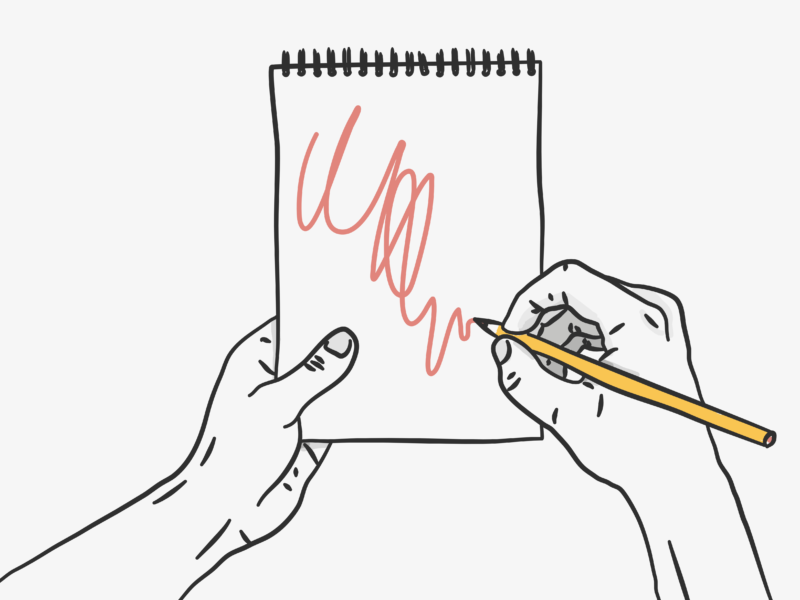Starting a new project, or business is a super exciting time, and it’s easy to get swept up and want to get started with the creative work as soon as possible. But it’s really important to sit down and work out what it is you want from your project and put it into a fully formed creative brief that will not only help you clarify your vision but also help your creative team deliver something that does what you want.
A creative brief is a kind of roadmap for your project. It lays out the background of your company, your aims and your audience and then paves the way for where you want to be going in the future. A good creative brief will outline a project’s aims, audience and expected deliverables.
These are my tips as someone who receives creative briefs as a designer, and also as someone who has had to write them in my day job working in marketing and communications.

WHERE SHOULD YOU START?
So, you have a great idea, right? Have you tested it? Do other people think it’s a great idea, and more importantly is it something people want or need? Before you even start writing your brief make sure you’ve done your research. Knowing the market and your idea is going to help you so much when you get down to writing your brief.
Then spend some time evaluating what it is you want from this project. If there are other people working in your team, sit down with them and see what they think and come to a conclusion together so you’re at least all starting from the same point.
Before you start a creative brief you need to know what other people think of your idea, and more importantly what you think about it.
SO, YOU KNOW WHAT YOU WANT, WHAT SHOULD YOU INCLUDE IN THE BRIEF?
- A quick bit of background to your company
- A paragraph about your project’s objectives
- A short paragraph about who your audience are, include any demographic information you have and any insights about what their wants and needs are.
- Your core message a few points about why it benefits to your audience
- The themes or images you imagine the creative work including and how important/literal that inclusion needs to be.
- The primary call-to-action or takeaway message you want to be included in the campaign
- Any examples of projects you’ve done in the past which have been successful or you’ve liked, and any projects you’ve seen and want the creative team to be inspired by.
- Brand and copy style guidelines (the master doc of fonts, colours, logos, copy tone, grammar guides and other elements that your brand uses). You don’t need to type all of this out in the brief, you can either attach alongside the brief, or give clear instructions on where to find it.
- Links or access to any background research and assets (e.g. photos of your products) the creatives might need or find useful.
- The specifications for the final product: file types, sizes, formats, etc. as well as where they need to be sent.
- All of your contact information, including your preferred means of contact, and an alternative contact in case you are away.
- The full list of things you need making. If it’s a long list, put them in priority order.
- Clear information about both launch dates and due dates for drafts (if these can be flexible let your team know), as well as information on how long you will take in getting draft approval back. This helps your creative team plan, and allows them to come up with ideas that will fit the timescale you have.
- You might also want to include what you’re hoping to achieve in terms of a return for the campaign, and whether that’s revenue, or views, or awareness etc.
This might seem like quite a long list, but it’s best to be explicit about your expectations – there’s nothing worse than getting halfway through a project and someone saying “oh but I had imagined it would include ducks, it really needs to have a duck in there somewhere” and nowhere in the brief is there a mention of a mallard.
WHAT DO YOU DO AFTER YOU’VE WRITTEN IT?
First, you need to edit it down to around 2 sides if possible. However, amazing it might be, no one wants to read a 50 page document (sorry). Just make sure you’re not cutting out something you really want to be included in the creative work.
Then put it down for a day, or longer, and come back to it. Ask yourself is this what I really want to achieve? Is there anything I’ve missed off? Is there anything that isn’t important in the long run?
Once you’re 100% happy with it. Send it over to your creatives and have a conversation about it. That conversation is absolutely key. It will give you chance to make sure everyone is on the same page, and understands the brief in the same way, and it gives your creative team chance to ask questions and challenge the brief. Clear communication is central to a successful project that everyone is happy with in the end.
THE MOST IMPORTANT THING TO REMEMBER
Writing a good brief takes time but putting the effort into nailing your project vision early in the process will save you time in the long run, and lead to a much more successful creative outcome. Use your brief to guide you, but don’t be afraid to re-evaluate it as you go if something changes, just make sure you’re communicating with everyone involved.



I always love the photos on your Blog posts!
Xo Victoria
Thanks so much Victoria, that means so so much!
Thank you so much for this, Natalie, referred by Lizzy but found this! My experience is that you have to have a clear goal on what you are trying to accomplish before starting out, eventually small details will be sorted out. Very useful 🙂
So glad you found something useful! I’d definitely agree that a clear goal is essential